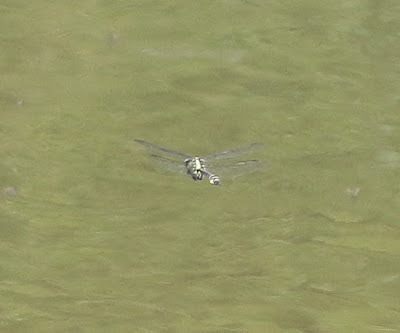Around the Bank Holiday weekend, my thoughts turned to looking at the weather for suitable sunny conditions to have another attempt to see Club-tailed Dragonflies. I had looked in June 2014 at the Goring-on-Thames site, but had been unsuccessful. I've tried to find another date in subsequent years to head back, but I've not been able to find good looking conditions on a free weekend. So I was interested when I saw one of the Dorset Birders had successfully seen Club-tailed Dragonflies at a site in Sussex on the Bank Holiday Sunday. A quick chat on social media & I had some directions. The weather looked good on the Bank Holiday Monday, so I left early hoping the traffic would be light: fortunately, it was. I arrived just before 11 & the weather forecast was spot on: sunny & still conditions. First problem was having to get past a number of young, inquisitive cattle on the riverbank. About ten minutes later, I saw my first Club-tailed Dragonfly, but it quickly disappeared out of view. Five minutes later, the next was happy to sit around for photos.
Club-tailed Dragonfly: Male. Club-tailed Dragonflies are initially tricky to see once the adults hatch as the teneral phase quickly head off to nearby treetops to mature
Club-tailed Dragonfly: Male. After a couple of weeks in the treetops, the mature adults return to the riverbank to mate
Club-tailed Dragonfly: Male. They range from Sussex to the Thames in Oxfordshire & across to the Severn on clean, slow-moving rivers
Club-tailed Dragonfly: Male
Club-tailed Dragonfly: Male. This one landed on the grass by the riverbank for a few minutes, before returning to patrolling the river
Club-tailed Dragonfly: Male. A couple of the males were patrolling the river over a 50 metre stretch
Club-tailed Dragonfly: Male
Club-tailed Dragonfly: Male. I didn't see any females so perhaps they were still to return to the river
Club-tailed Dragonfly: Male. The males were sitting around close to the river to look for the females as they returned from the treetops
There were also large numbers of Banded Demoiselles & smaller numbers of Large Red Damselflies along the river bank.
Banded Demoiselle: Male. They were very common along the riverbank, but I only took a few photos of them as I've taken a lot of photos in previous years
Banded Demoiselle: Male. They are even more stunning when seen close up
Banded Demoiselle: Female
Banded Demoiselle: Female
Banded Demoiselle: Males. I really like this photo
Large Red Damselfly
I also saw a Shieldbug which I wasn't sure which one it was at the time, but it looked familiar. But the beauty of having a decent camera meant I could photograph it & work it out later, when I had the book handy.
Coreus marginatus: This widespread Shieldbug occurs as an adult from August to July & prefers dense vegetation along hedgerows, wasteland & damper areas. I was right, I had seen it before
Coreus marginatus: I saw several without any real searching
I also saw this presumed pair of Beetles, which I've not managed to identifying yet.
Beetle sp.: Any thoughts about the identification?





























































